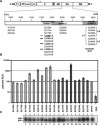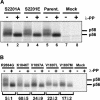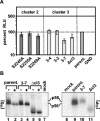Mutational analysis of hepatitis C virus nonstructural protein 5A: potential role of differential phosphorylation in RNA replication and identification of a genetically flexible domain
- PMID: 15709040
- PMCID: PMC548472
- DOI: 10.1128/JVI.79.5.3187-3194.2005
Mutational analysis of hepatitis C virus nonstructural protein 5A: potential role of differential phosphorylation in RNA replication and identification of a genetically flexible domain
Abstract
Nonstructural protein 5A of the hepatitis C virus (HCV) is a highly phosphorylated molecule implicated in multiple interactions with the host cell and most likely involved in RNA replication. Two phosphorylated variants of NS5A have been described, designated according to their apparent molecular masses (in kilodaltons) as p56 and p58, which correspond to the basal and hyperphosphorylated forms, respectively. With the aim of identifying a possible role of NS5A phosphorylation for RNA replication, we performed an extensive mutation analysis of three serine clusters that are involved in phosphorylation and hyperphosphorylation of NS5A. In most cases, alanine substitutions for serine residues in the central cluster 1 that enhanced RNA replication to the highest levels led to a reduction of NS5A hyperphosphorylation. Likewise, several highly adaptive mutations in NS4B, which is also part of the replication complex, resulted in a reduction of NS5A hyperphosphorylation too, arguing that alterations of the NS5A phosphorylation pattern play an important role for RNA replication. On the other hand, a deletion encompassing all highly conserved serine residues in the C-terminal region of NS5A that are involved in basal phosphorylation did not significantly affect RNA replication but reduced formation of p56. This region was found to tolerate even large insertions with only a moderate effect on replication. Based on these results, we propose a model of the role of NS5A phosphorylation in the viral life cycle.
Figures




References
-
- Bartenschlager, R., M. Frese, and T. Pietschmann. 2004. Novel insights into hepatitis C virus replication and persistence. Adv. Virus Res. 63:71-180. - PubMed
-
- Blight, K. J., A. A. Kolykhalov, and C. M. Rice. 2000. Efficient initiation of HCV RNA replication in cell culture. Science 290:1972-1974. - PubMed
Publication types
MeSH terms
Substances
LinkOut - more resources
Full Text Sources
Other Literature Sources
Research Materials

